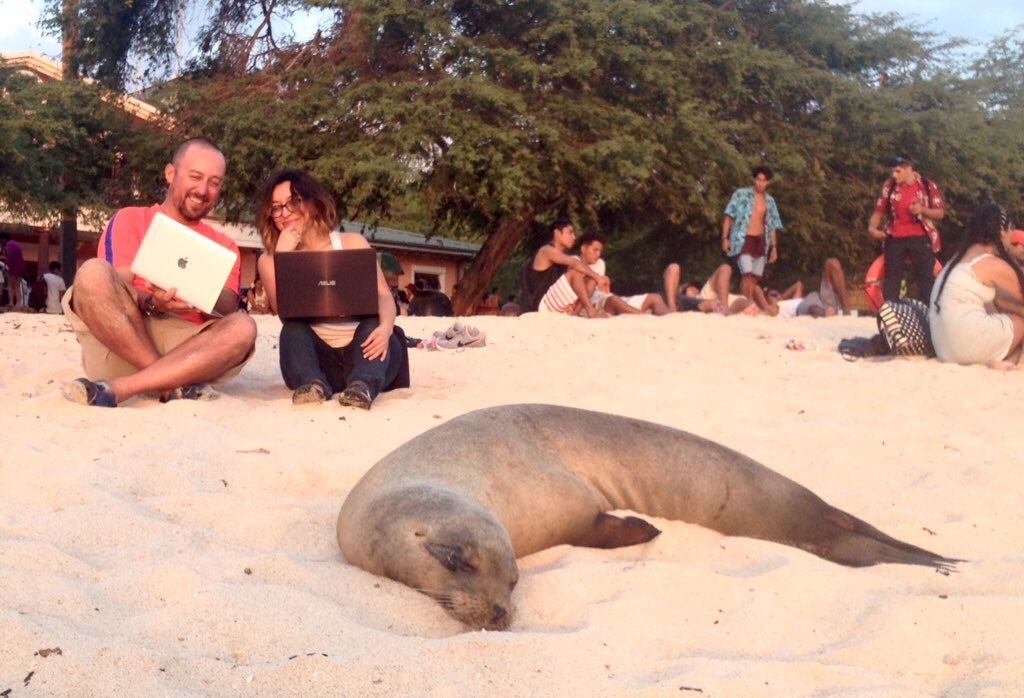With a research focus on statistical ecology, and an already large record of research publications, Vianey works on such amazingly fascinating projects such as analyzing data in shark movements and snake tracking. She has swum with sharks in the Galapagos Islands and has gaped over sheep in Patagonia, but her favourite animals are her own two cats, Gaara and Strax.
One of her newest passions is environmental statistics, with a focus on spatial modelling of disease data; meaning the mapping of bacterial occurrences, for example to pinpoint to environmental issues.
She is most proud of her interdisciplinary work and collaborations with people across the world, especially those that have pushed her to new domains and into exciting challenges.
Yet, even more interesting than her research is her personal background as the daughter of previously undocumented immigrants in the United States and her path into the field of statistical and environmental sciences. And, she is the first Latin American faculty member in the Department of Statistical Sciences!
U of T Statistical Sciences: Welcome to the StatsSci team and congrats on your new role! What got you interested in U of T and the Stats Department?
Thank you! I’m so incredibly excited to be here.
My joint position between Statistical Sciences and the School of the Environment is my absolute dream job, and I love that the Statistical Sciences department actively promotes and values interdisciplinary research. Not only does the department encourage me to continue my shark science education and other ecological education, it’s now part of my job! I can’t imagine a better fit for me.
I love that the Statistical Sciences department actively promotes and values interdisciplinary research.
Sharks, snakes, and sheep; we are dying to learn more about your research!
The main idea behind my applied work in animal movement is that animals inherently perform different behaviours over time, and I try to come up with statistical models that can detect biologically relevant patterns. We use these patterns to understand when and where animals may perform functions like resting and eating, as well as where they tend to go and at what time of day they tend to be more active, for example in the case of sharks.
Learning about the ways in which the animals are tagged and monitored is an amazing perk; it always feels like I’m in a science documentary! I hear stories about traveling out to the middle of the ocean to tag sharks, placing collars on sheep in Patagonia, and video tracking of a carefully placed red dot on a baby snake’s head.
What fascinates you about animal movement? And what are some insights you and your colleagues have gained from your research in this field?
Growing up, I was always fascinated when documentaries would show amazing maps and trackings of where the animals went. But because I loved math, I inherently knew that there must be a way to be the mathematician on the team that analyzed the data.
And now in my work, we not only try to see where they go, but what types of behaviors the animals exhibit and where. My colleagues have learned a ton about shark activity patterns and baby snake personalities. I have another project that aims to understand how the condition of a sheep affects its movements and landscape usage.
Where is the link from the animal behaviours you describe to the field of statistics?
In my own statistical research, I frequently work with Markov-switching models. It’s quite intuitive to use them when trying to model a set of different behaviors exhibited over time. The challenge with the data is that it can be quite messy, and it can also be difficult to select the appropriate mathematical structures to capture the relevant behaviors, but it’s quite interesting. We can also never, or rarely, really observe what the free-ranging animals actually do, so I have to depend quite heavily on my collaborators to make sure that my models are in line with their domain expertise.

What are some particularly memorable moments you can recall?
One of my most memorable moments was when I got to go out for a research visit to the Galapagos Islands to work with Alex Hearn, a professor at the Universidad San Francisco de Quito in Ecuador. We’re still finishing up the analysis on hammerhead sharks, but while there, he took me to snorkel with blacktip and hammerhead sharks. I got to see the study animal in the wild! I also saw sea turtles, eagle rays, loads of amazing birds and other wildlife while there.
Most of my memorable moments usually involve chatting and visiting with domain experts about their marine and other ecological work. Like, getting to see sharks at the Shark Lab at California State University, Long Beach, seeing the collared Merino sheep in person in Argentina, watching cute videos of sharks munching on urchins and then matching that behavior with the acceleration signal. It’s loads of fun.
I often see my models fail quite spectacularly when applied to animal movement data, and other environmental time series data, so diving back into the theory and emerging with fundamental understandings of why it failed is quite enriching.
Were there any aha! moments in your research history?
Most of my ‘aha!’ moments have been related to my statistical research. There’s a rich statistical literature on the topics that I tend to work on. However, I often see my models fail quite spectacularly when applied to animal movement data, and other environmental time series data, so diving back into the theory and emerging with fundamental understandings of why it failed is quite enriching. These types of problems are going to be the main focus of my statistical research for the next few years.
I love the role that statistics plays in the advancement of science. For instance, that I, without any formal biological background, can collaborate with marine biology researchers to further shark science, is amazing.
A new research interest of yours is in the area of environmental statistics. Can you tell us more about that?
Part of my postdoctoral work was to develop spatial models for the occurrence of Nontuberculous mycobacteria (NTM) in the Hawaiian Islands. NTM can lead to lung disease in humans, and can be difficult to treat, so it’s important to understand what conditions lead to a higher prevalence of it. Since then, I’ve developed a bigger interest in the area of disease ecology and spatio-temporal modeling. Many researchers, both in Statistical Sciences and the School of the Environment, do similar work, so I’m quite excited to learn more from them.
What is it about statistics in general that fascinates you?
I love the role that statistics plays in the advancement of science. For instance, that I, without any formal biological background, can collaborate with marine biology researchers to further shark science, is amazing. Statistics allows me to collaborate with a variety of researchers and learn about many other disciplines.
What was your path into statistics? Or, more specifically: How did you end up being a Statistician?
I had a few different majors before I arrived at statistics, but, of course, none of them really worked out. I nearly failed out of my undergraduate institution before I decided that I loved math and wanted to go all in. I was looking to do undergraduate research on something more applied, and another Latino professor who worked in statistics had just joined the faculty and was open to working with me. From there, I’ve never looked back.
Statistics allows me to collaborate with a variety of researchers and learn about many other disciplines.
You have a fascinating personal background. Would you be comfortable sharing your unique life story?
I was born in Leon, Guanajuato, Mexico, but was taken to the USA while very young. I grew up undocumented until I was about 14 years old, so a freshman in high school. I was lucky to obtain my permanent residency before I graduated high school as it didn’t affect my opportunity to receive funding to attend university, but not all children are as lucky as I was. Much of the adversity I’ve faced I’ve only come to acknowledge after the fact. Usually this happens when I talk about my path, what I had to go through, and then others will chime in and mention that it wasn’t normal or they never had to go through something like that.
I also grew up in a bilingual and bicultural household, so now I’m fluent in both Spanish and English, and frequently conduct research in both languages. I’m hoping to use that to my advantage to recruit more students from Latin America, as well as support the immigrant students at UofT, regardless of country of origin.
Toronto is an amazing fit for me in so many ways!
Yes! And how have your first few weeks in Toronto been?
I was in quarantine during my first two weeks in Canada, which was not so fun but also, naturally, necessary! I’ve spent the past week running errands and walking around downtown Toronto. I found good tacos and a market that sells Mexican ingredients, so I’m all set!
What courses will you be teaching?
I’ll be developing a course for the School of the Environment that I’ll then teach in Fall 2021. We’re going all in on ‘environmental data science’ and I absolutely cannot wait to work with students from the SoE. They’ll be out there trying to save the world with data science in no time.
I hope to challenge my students to think a bit outside of their research area.
What do you hope to accomplish in your tenure at U of T?
My primary goal is to build various communities. That could entail an ‘ecological and environmental statistics’ community, a community of environmental data scientists, a community of environmentally minded people at U of T, etc. I love working with others and find that a feeling of community tends to make for a better academic experience for students as well.
As a teacher, I hope to challenge my students to think a bit outside of their research area. In statistics, I hope the students learn to think more about how their work ties into the research domain of others. And on the school-of-the-environment side, I’d like to guide students to think more carefully about how statistics is part of a conservation, policy and/or social justice narrative.
Do you have some fun facts about yourself you could share? Any interesting hobbies?
I collect Agatha Christie novels, and have read nearly everything she’s written. Hopefully soon enough I can go out to the used bookstores around Toronto to search for rare and older editions of her work.
I also like to take my cats out for walks - they walk with a harness on! And I enjoy discovering new murals as I walk around the city.
My post-COVID goal is to get SCUBA certified!
© 2020 U of T Statistical Sciences


